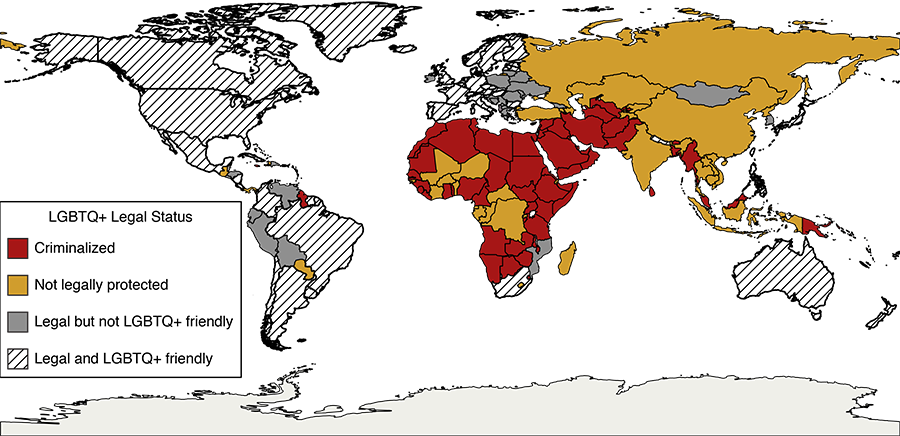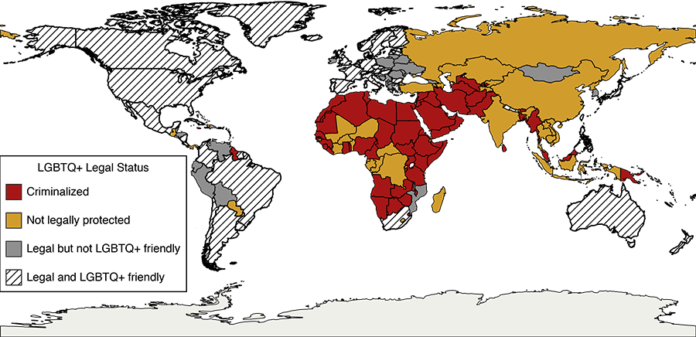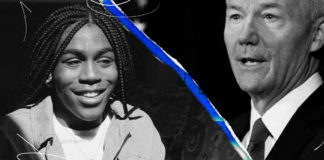Fieldwork is often framed as central to geoscience research. What fieldwork comprises varies across geoscience disciplines and can encompass everything from wilderness treks, oceanographic cruises, and class field trips to museum and laboratory visits, trips to research centers, and attending conferences around the world. What varies just as widely, unfortunately, is how safe field research and work-related travel are to the geoscientists who must perform it.
There is increasing awareness of the hazards of sexual harassment and assault in the field-based sciences and a growing understanding that fieldwork is not always accessible for geoscientists with varying physical abilities or young families. However, there has not been a deliberate focus on challenges faced by the lesbian, gay, bisexual, transgender, and queer (LGBTQ+) community in the geosciences with respect to fieldwork.
This is not to say that interventions for other discrete groups cannot help members of the LGBTQ+ community. People are complex, and their identities intersect many realms—there are, of course, LGBTQ+ geoscientists with disabilities and those with young children. However, it is often assumed that interventions intended to help one minoritized group will help all such groups—“a rising tide lifts all boats” approach. For instance, in the seminal study on harassment in the field [Clancy et al., 2014], the authors noted that “our results cannot adequately speak to the experiences of people of color or [LGBTQ+] individuals because they are under-represented in our fields and therefore our dataset, but the experiences reported by our respondents are likely reflective of a broader climate for members of various minority groups.”
But without data, this widely held assumption cannot be assessed. One of the biggest barriers to supporting the LGBTQ+ geoscientist community is that to date, there have not been many systematic attempts to describe and understand this community. Individual geologists have shared their stories in places like 500 Queer Scientists or in the media, which is a crucial way of increasing visibility, but storytelling does not help assess the needs and challenges of the community as a whole.
This lack of information is not limited to the geosciences. Every 2 years the National Science Foundation publishes reports on the state of “women, minorities and persons with disabilities” in science and engineering but has not yet collected information on LGBTQ+ scientists. There have been some efforts to collect data about LGBTQ+ scientists in physics and chemistry, as well as across all science, technology, engineering, and mathematics (STEM) fields. One 2016 study surveyed 1,603 LGBTQA STEM professionals, including 108 geoscientists, although the data were only published in aggregate [Yoder and Mattheis, 2016].
First, Quantify the Community
To better understand the needs and struggles of LGBTQ+ geoscientists, we launched a survey in fall 2019 that grew out of one author’s (M.R.D.) attempt earlier that year to connect with his own community. As part of a presentation to an on-campus branch of the organization Out in STEM, he tweeted an informal survey trying to understand the concerns of other LGBTQ+ paleontologists. The results revealed that many of these scientists felt unseen, unheard, and unsupported in their field. The responses to the informal survey prompted us to conduct an official survey of geoscientists, modeling ours on that of Yoder and Mattheis [2016]. Once we were granted permission from the human subjects board at our university, we conducted the survey online, as studies have shown that this is the best way to collect information related to identity [McInroy, 2016].
On the basis of 261 responses, we found that the geosciences contain a diverse LGBTQ+ community. Most participants identified as cisgender women (47%) or as transgender (an umbrella term that includes transgender man, transgender woman, nonbinary, genderqueer/genderfluid, agender, and other identifiers for people whose gender does not strictly match the gender they were assigned at birth; 31%), with 22% identifying as cisgender men. Diverse sexualities are also represented, dominated by bisexual/pansexual/queer identities (52%), followed by gay/lesbian identities (34%), and then asexual/demisexual/romantic-spectrum identities (14%).
These results also revealed that the composition of the LGBTQ+ community in the geosciences is different from what has been found in STEM in aggregate, as well as in physics in the United States and the United Kingdom. By comparison, there are fewer gay men and a higher proportion of women and nonbinary/genderqueer and bisexual people in the geosciences. The racial demographics of LGBTQ+ participants in our survey were similar to those of the geosciences as a whole, as 83% of the respondents were white, 8% were Asian, and 7% were Hispanic/Latinx, while the remaining 3% were Black, Native American, or Pacific Islander.
Then Quantify the Problem
Although the survey asked about many experiences in the geosciences track, we were particularly struck by the data we collected on fieldwork and remote research. When asked about experiences with fieldwork or remote research, almost 55% of respondents indicated that they had been in an area where they did not feel safe because of their identity, expression, or presentation. Furthermore, about a third of the respondents indicated that they have refused to do fieldwork because of concerns for personal safety related to their identity. The need for these concerns becomes clear when looking at a world map highlighting where LGBTQ+ identities are not protected or are even criminalized (Figure 1). Even in places where these identities are not categorized as unlawful, the dominant culture may not be LGBTQ+ friendly.

These findings are striking, both in their scale and in how widespread they are. For instance, Clancy et al. [2017] conducted a methodologically similar study of astronomers and planetary scientists identifying those likely to feel unsafe in their workplaces because of gender (women, 35%; men, 1%) and race (women of color, 28%; men of color, 1.5%; white men and women, <1%). Our data show that a majority of individuals in all demographic groups identified by Clancy et al. who also identify as LGBTQ+ have felt unsafe with fieldwork or remote research experiences, and 34% refuse to do fieldwork over fears related to their identity. In fact, 62% of cisgender white men reported feeling unsafe in the field due to their LGBTQ+ identity; the only group that reported feeling more unsafe was cisgender women of color (75%). Cisgender women of all races and transgender people of color reported the highest rates of refusing to do fieldwork because of safety issues (50% and 46%, respectively).
Support Is Lacking for Graduate Students
Another troubling finding of our survey is that LGBTQ+ graduate students (29%) are significantly less likely than professors (57%) to have opted out of fieldwork in a specific locality because of safety fears. This is not surprising given the power imbalances present in graduate programs; a graduate student’s research is often done in consultation with faculty advisers as part of a larger research agenda, which means that relative to faculty, students typically have far less control over their field site selection.
This power imbalance speaks to the need for graduate programs to develop adequate support and mentorship for LGBTQ+ graduate students, a need that is echoed in the survey responses. Most respondents (87%) reported that increased LGBTQ+ mentorship would have been helpful during their time as a student. Responses indicated that faculty support for the LGBTQ+ community was low both inside and outside the classroom, with 85% and 69% of respondents, respectively, reporting rarely or never experiencing such support. These two metrics are correlated: A student who experiences in-class support is likely also to have experienced out-of-class support.
Compounding the lack of available support, the overwhelming majority (85%) of respondents felt that other LGBTQ+ people in geology were not visible during their time as a student, presenting a challenge to them to even seek out and solicit mentorship. An even greater majority (91%) expressed that greater visibility and representation of LGBTQ+ people in geology would have been helpful during their time as a student, both in the field and at their home institution.
Using Data to Support LGBTQ+ Geoscientists
Given that almost all respondents wished for visible representation and that individuals in all demographic groups have felt unsafe doing fieldwork or remote research, it’s clear that existing interventions to make the geosciences more inclusive are not sufficient for LGBTQ+ geoscientists. These findings are key for developing solutions for challenges faced by the LGBTQ+ geoscientist community.
Advisers, employers, and institutions need to be aware of safety issues associated with fieldwork and to educate themselves about potential dangers to LGBTQ+ geoscientists at field sites. However, the need for support and mentorship goes beyond the field [Mulcahy et al., 2016]. In the classroom, support for LGBTQ+ students starts with professors confronting homophobia, using inclusive language, and using students’ preferred pronouns. Out of the classroom, faculty and staff can engage in supportive academic advising, visible allyship, and diversity training. Such gestures may seem small but are, in fact, tremendously meaningful. LGBTQ+ students report that a crucial part of their overall success is having a mentor to whom they are comfortable disclosing their identity.
Over the past few years, the geosciences community has been trying to broaden participation by making fieldwork and conferences more accessible and welcoming. Our survey makes clear that we need to reach out further to explicitly support the LGBTQ+ community. An important place to start is with education and awareness that allow our LGBTQ+ colleagues to be safe and feel supported in the field.
Acknowledgments
The authors thank Patrick Getty, T. K. Morton, Khye Blue, and Colleen Wynn for feedback on the initial survey and A. Bradley for providing additional data. We received approval from the Human Research Protection Program at the University of Kansas (IRB ID: STUDY00144586) for human subject testing for the survey.








